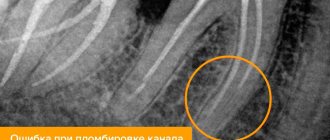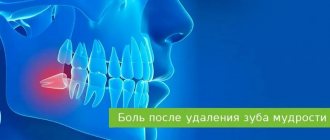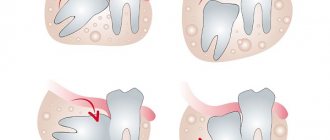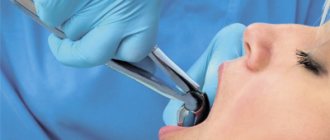Wisdom teeth (third molars, “eights”) are rightfully considered the most problematic teeth. For a rare lucky person, their eruption proceeds safely. After all, even if the number eight has enough space in the dentition - which is rather an exception in modern realities - while passing through the gums, this large multi-tubercular tooth causes a lot of suffering to its owner. That is why in America, for example, wisdom teeth are removed prophylactically, before eruption - even during their formation.
What problems can arise from wisdom teeth?
Causes of caries
The main reason for the appearance of caries in wisdom teeth is their location. The third molars erupt last and at the very end of the dentition. The distant location greatly complicates the process of daily brushing of teeth. If the lower eights are visually accessible and if the cleaning with a toothbrush is poor, the procedure can be repeated, then the upper molars remain in a “blind” and hard-to-reach area.
Bacterial plaque, which gradually accumulates on the walls of the tooth, begins to destroy the enamel. Due to the absence of signs of damage at the initial stage and poor visibility of the tooth itself, the carious process progresses and penetrates deeper. As a rule, people turn to the dentist already at the stage of deep caries or pulpitis.
The cause of wisdom teeth caries can also be:
- carious lesion of the adjacent tooth;
- caries of the opposite eight.
Impacted, that is, partially erupted figure eights, are also often affected by caries, despite the fact that they are partially hidden by the gum. With insufficient hygiene, food particles and bacterial deposits penetrate under the gingival hood. As a result, the process of tissue destruction begins.
Carious lesion of the wisdom tooth and the adjacent “seven”
It takes a lot of effort to really clean teeth that are far from the center, so their level of hygiene usually leaves much to be desired. They do not take an active part in the chewing process, so they also do not clean themselves. In the accumulating plaque, pathogenic microflora very quickly develops, causing the need for treatment of caries. Since, due to lack of space, the “figure eight” is often located obliquely, caries also affects the adjacent tooth - in the area of their contact.
Which is better: removal or treatment?
If on other teeth a carious lesion is an indication for treatment and removal is carried out only in case of serious complications, then when eights are affected the situation is always ambiguous.
It is not always possible to treat wisdom teeth caries. Mostly, treatment is used when the lower eights are affected, access to which is more free. Upper jaw caries of wisdom teeth is much more difficult to treat, since the dentist does not always have access to the center of the carious lesion and, even more so, cannot carry out high-quality cleaning and filling of the canals when the infection penetrates deeply.
For this reason, dentists often recommend removing decayed wisdom teeth if:
- the diseased molar is located on the upper jaw;
- caries is diagnosed at a deep stage;
- the tooth has crumbled and cannot be restored;
- there is no figure eight on the opposite jaw;
- the tooth is dystopic or impacted;
- the root system is twisted.
Wisdom tooth caries should be treated when the lesion is detected at the initial or middle stage, the tooth does not have any anomalies in eruption and formation, or it will serve as a support for the prosthesis during the planned prosthetics.
Why are “eights” considered the most “difficult” teeth?
The eruption of third molars occurs at an age when the jaw bones slow down and stop growing, and there is simply not enough space for them in the already formed dentition. In addition, in the place where the “eight” should erupt, there was no milk tooth. Therefore, a person whose wisdom tooth is cutting experiences significant pain, weakness, and lacks appetite. The soft tissues surrounding the tooth become inflamed, and the body temperature rises to low-grade fever.
The process can go on, intermittently, for several months, and inflammation can lead to unpleasant and dangerous purulent complications and other undesirable consequences.
Features of wisdom teeth treatment
Wisdom tooth decay is treated using the same algorithm as regular teeth. The procedure is performed under local anesthesia, but therapeutic manipulations can also be performed under sedation. This method of anesthesia is recommended for a planned long-term procedure, treatment of the figure eight of the upper jaw, an increased gag reflex and limited mouth opening.
The features of the manipulations depend on the indications. The initial and middle stages of the disease will only require the removal of tissue affected by caries and the installation of a filling.
Deep caries is an indication for a more complex procedure:
- tissues affected by caries are removed using a drill;
- tooth canals are cleaned;
- antiseptic treatment is performed;
- a medicine is placed into the tooth cavity;
- a temporary filling is installed;
- after 3–10 days the temporary filling is removed;
- antiseptic treatment is repeated;
- A permanent filling, inlay or crown is installed.
Treatment of wisdom teeth caries should only be performed by an experienced dentist. If mistakes are made during the procedure, the likelihood of complications or relapse is very high. When re-applying, the eights are usually deleted.
Individual oral hygiene after wisdom tooth removal.
- For 3 days, you should not rinse your mouth vigorously, as this can lead to sutures coming apart and bleeding;
- You should brush your teeth and tongue as usual twice a day, without touching the postoperative area with a toothbrush;
- After each meal, carefully rinse your mouth with a warm decoction of chamomile, sage, arnica or oak bark, which has a mild antiseptic and tannic effect. If you don’t have any decoctions on hand, you can use chamomile or regular black tea (a strong solution);
How does the removal work?
If there are indications for the removal of wisdom teeth with caries, the procedure is performed exclusively by a dental surgeon. Depending on the condition of the tooth and the characteristics of its development, simple or complex extraction can be performed.
Simple removal involves the usual manipulation of tooth extraction using forceps. But such a procedure is only possible if the only pathology is caries.
Most often, third molars require complex removal, which involves dental surgery and surgery. Complex removal is necessary for pathology of the root system, destruction of more than 50% of the tooth surface, dystopia or retention. During the procedure, the dentist may resort to cutting soft tissue, breaking the tooth and removing it in parts and other manipulations.
After removal of wisdom teeth with caries, an x-ray diagnosis is required to exclude remnants of parts of the tooth or root. After this, stitches are applied.
Pericoronitis of the wisdom tooth is a serious danger to health and even life
Between the erupting tooth and the gum a so-called “hood”, which promotes the accumulation of food debris and the growth of colonies of pathogenic bacteria. Ideal conditions are created for the development of pericoronitis - a purulent inflammatory process. In this case, the gums swell and swell, the body temperature rises, the patient experiences severe pain, and an unpleasant taste and smell appears in the mouth. The inflammatory process can spread to the periosteum, causing periostatitis, and even to the bone tissue of the jaw, causing a deadly disease - osteomyelitis.
Wisdom tooth hurts after treatment
Often, patients who have undergone wisdom teeth treatment for caries complain of pain for a long time. Pain syndrome is normal, since figure eights have a more complex structure and have increased sensitivity.
After conservative treatment, pain is considered normal, which decreases in intensity within 5–7 days and then disappears completely. After extraction, due to the persistence of a large wound and traumatic manipulations, pain in the area of the extracted tooth may be felt for 10–14 days. After two weeks, the pain should be eliminated or almost not felt.
If the pain lasts longer or the sensations cause severe agony, you should immediately contact a specialist. Complications may develop that require immediate dental attention.
Wisdom teeth are difficult to treat; due to the lack of their functional significance in the presence of acute processes, dentists do not recommend saving the tooth. To avoid the consequences of caries of eights, experts advise visiting a dental clinic every 6 months for a preventive examination and professional teeth cleaning.
Wisdom tooth: inflammation of the hood and its symptoms
Patients who have inflamed gums near a wisdom tooth usually complain to the doctor that their wisdom tooth is growing, their gums are swollen, and there is also an odor from the wisdom tooth. The formation of an unpleasant odor is caused by the formation of pus, which is gradually released from under the hood. Patients also complain of pain in the area of the wisdom tooth. Such symptoms correspond to only a mild form of pericoronitis.
What do the symptoms of pericoronitis look like in the video? Please note that in the video below you can see the following symptoms: redness and swelling of the hood above the upper wisdom tooth, a small amount of purulent discharge (white) from under the hood. Such symptoms correspond to a mild form of inflammation.
If pericoronitis occurs, treatment is only possible with a dental surgeon. But at the initial stage, patients try to relieve the symptoms on their own using available means: antiseptic rinses, dental drops, painkillers. In most cases, this is ineffective and the inflammation only increases. The following symptoms increase (in various combinations):
increasing pain- severe swelling and redness of the gums,
- swelling of the cheek (Fig. 4),
- purulent discharge from under the hood,
- painful swallowing
- difficulty opening the mouth,
- increase in body temperature,
- weakness,
- swelling and tenderness of the submandibular lymph nodes.
Important: if at this stage the wisdom tooth hood has not yet been removed (see below), then you should be prepared for the next development of events. Firstly, because inflammation occurs in the area of the masticatory muscles - their spasm can lead to almost complete closure of the mouth. If at this moment you decide to go to the dentist, then he will not be able to do anything for you if your mouth is not opening enough, except to refer you to the hospital.
Secondly, pus may begin to spread not into the oral cavity, but rather deep into the bone and soft tissues, which will cause the formation of an abscess or phlegmon (peripharyngeal or submandibular). The latter complications will also mean inevitable treatment in a hospital, and therefore it is better not to bring the inflammation of the wisdom tooth to a critical level.
What not to do after suturing.
- don't rinse your mouth! Mouth baths in the first 3-5 days are more than enough;
- do not use hot compresses! This is fraught with the appearance of edema and the development of inflammation;
- do not create a vacuum in your mouth: do not puff out your cheeks, sneeze, blow your nose and spit very carefully;
- do not pick the wound, do not touch the clot with your tongue;
- do not drink or eat hot or cold food, only warm food;
- try to quit smoking for at least 2-3 days after surgery;
- Do not drink alcohol for 2-3 days - it does not promote tissue repair. Also rule it out if your doctor has prescribed a course of antibiotics;
- Do not overcool or overheat - give up sports exercises, swimming pools, saunas for 5-7 days.
What to do if the bleeding does not stop
Immediately after removing a molar, the surgeon places a tampon on the socket to stop capillary bleeding. The patient needs to clench his jaw and not remove the tampon for 20 minutes. During this time, the blood coagulates and a clot forms in the hole, protecting the fresh wound from the penetration of bacteria into it.
If the patient has high blood pressure or poor blood clotting, the tampon should be kept in place for 40-60 minutes.
When a person strictly adheres to medical recommendations, but the bleeding does not stop, he should contact a dentist for help.
Reasons for the formation of pus in the gums
There are several reasons for the formation of pus:
- The inflammatory process causes a disease such as periodontal disease (gingivitis).
- Periodontal disease.
- Mechanical damage to the gums.
- Chemical or thermal burn.
- Unprofessional removal of tartar, which affected the gums.
- Extensive caries causes pulpitis.
- Failure to comply with hygiene standards when performing dental procedures.
- Unsanitary oral cavity.
- Types 1 and 2 diabetes mellitus.
- Summing up the causes of purulent inflammation of the gums, we can highlight the main factor that causes this disease – the vital activity of pathogenic microorganisms.
Removal of the lower impacted figure eight
A common complication is wisdom tooth retention, which is incomplete eruption. It can erupt above the gum as part of the crown or as one or two bumps. In this case, the second part of the crown will be covered with a gingival hood. With insufficient hygienic care, food accumulation, gum inflammation, and pericoronitis (inflammation of the hood) occur. In the case of pericoronitis, the dentist excises or cuts the gingival hood. But if the situation is constantly repeated and bothers you, then it is better to remove such a tooth. Chronic inflammation of the gums is a source of infection that spreads throughout the body and can provoke an exacerbation of other diseases.
Bleeding
If bloody discharge appears from the socket of an extracted wisdom tooth, you should call your doctor and report the situation. Minor gum bleeding can occur due to tissue injury, high blood pressure, or problems with blood clotting. In most cases, this does not threaten health and goes away on its own. If bleeding is severe or frequently repeated, you should inform your doctor and come for an examination. To prevent complications, you should rest more for several days, avoid physical activity, and monitor your blood pressure.
Pain in the socket
Everyone experiences pain after removal surgery and worries for several days. The intensity of pain will depend on the traumatic nature of the operation and the complexity of the surgical interventions. During the postoperative period, the dentist recommends using painkillers. If the pain does not disappear, but intensifies after 3-4 days, this may indicate complications. A professional examination and consultation with a doctor are required.
How to understand that complications have arisen after suturing?
Alarming symptoms after removing the “eight” are as follows:
- heavy bleeding that lasts more than a day;
- severe pain, throbbing pain that prevents you from sleeping or leading a normal life;
- very large swelling;
- redness in the intervention area;
- blood in saliva in the first three days after the intervention;
- elevated body temperature.
In all these cases, you must consult your doctor. It is possible that stitches will have to be stitched again to avoid complications.
Easy removal
Simple extraction is the extraction of a tooth without the use of additional tools or techniques. A simple operation is observed after complete eruption, correct positioning of the molar, and the absence of serious pathologies. The doctor applies forceps and, after rocking movements, removes the molar from the jaw
The following stages of the procedure can be distinguished:
- Anesthesia;
- Selection and preparation of tools;
- Tooth ligament separation;
- Application and fixation of forceps;
- Luxation of a molar;
- Extraction from bone;
- Checking the hole;
- Stop bleeding;
- Recommendations for the patient.











